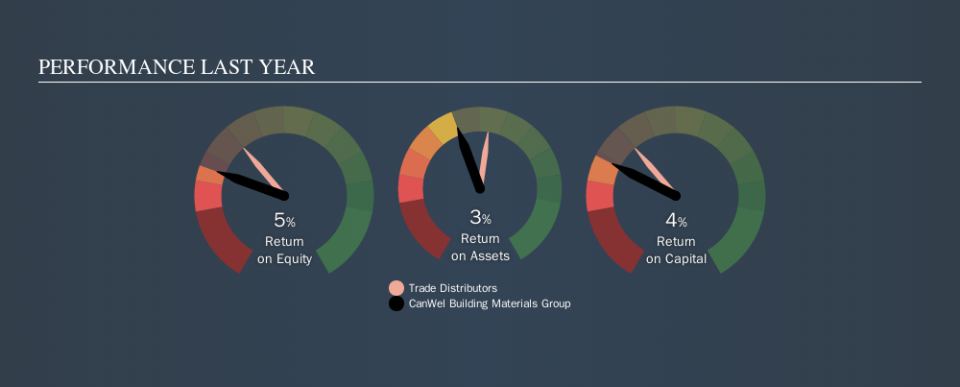Why You Should Care About CanWel Building Materials Group Ltd.’s (TSE:CWX) Low Return On Capital

Today we are going to look at CanWel Building Materials Group Ltd. (TSE:CWX) to see whether it might be an attractive investment prospect. Specifically, we're going to calculate its Return On Capital Employed (ROCE), in the hopes of getting some insight into the business.
First, we'll go over how we calculate ROCE. Next, we'll compare it to others in its industry. Then we'll determine how its current liabilities are affecting its ROCE.
Understanding Return On Capital Employed (ROCE)
ROCE is a metric for evaluating how much pre-tax income (in percentage terms) a company earns on the capital invested in its business. In general, businesses with a higher ROCE are usually better quality. In brief, it is a useful tool, but it is not without drawbacks. Author Edwin Whiting says to be careful when comparing the ROCE of different businesses, since 'No two businesses are exactly alike.
How Do You Calculate Return On Capital Employed?
The formula for calculating the return on capital employed is:
Return on Capital Employed = Earnings Before Interest and Tax (EBIT) ÷ (Total Assets - Current Liabilities)
Or for CanWel Building Materials Group:
0.044 = CA$38m ÷ (CA$1.0b - CA$174m) (Based on the trailing twelve months to June 2019.)
Therefore, CanWel Building Materials Group has an ROCE of 4.4%.
Check out our latest analysis for CanWel Building Materials Group
Does CanWel Building Materials Group Have A Good ROCE?
ROCE is commonly used for comparing the performance of similar businesses. We can see CanWel Building Materials Group's ROCE is meaningfully below the Trade Distributors industry average of 12%. This could be seen as a negative, as it suggests some competitors may be employing their capital more efficiently. Independently of how CanWel Building Materials Group compares to its industry, its ROCE in absolute terms is low; especially compared to the ~1.9% available in government bonds. It is likely that there are more attractive prospects out there.
We can see that, CanWel Building Materials Group currently has an ROCE of 4.4%, less than the 7.1% it reported 3 years ago. So investors might consider if it has had issues recently. The image below shows how CanWel Building Materials Group's ROCE compares to its industry, and you can click it to see more detail on its past growth.
When considering this metric, keep in mind that it is backwards looking, and not necessarily predictive. ROCE can be misleading for companies in cyclical industries, with returns looking impressive during the boom times, but very weak during the busts. ROCE is, after all, simply a snap shot of a single year. What happens in the future is pretty important for investors, so we have prepared a free report on analyst forecasts for CanWel Building Materials Group.
What Are Current Liabilities, And How Do They Affect CanWel Building Materials Group's ROCE?
Current liabilities are short term bills and invoices that need to be paid in 12 months or less. The ROCE equation subtracts current liabilities from capital employed, so a company with a lot of current liabilities appears to have less capital employed, and a higher ROCE than otherwise. To counteract this, we check if a company has high current liabilities, relative to its total assets.
CanWel Building Materials Group has total assets of CA$1.0b and current liabilities of CA$174m. Therefore its current liabilities are equivalent to approximately 17% of its total assets. This is a modest level of current liabilities, which will have a limited impact on the ROCE.
Our Take On CanWel Building Materials Group's ROCE
CanWel Building Materials Group has a poor ROCE, and there may be better investment prospects out there. Of course, you might find a fantastic investment by looking at a few good candidates. So take a peek at this free list of companies with modest (or no) debt, trading on a P/E below 20.
There are plenty of other companies that have insiders buying up shares. You probably do not want to miss this free list of growing companies that insiders are buying.
We aim to bring you long-term focused research analysis driven by fundamental data. Note that our analysis may not factor in the latest price-sensitive company announcements or qualitative material.
If you spot an error that warrants correction, please contact the editor at editorial-team@simplywallst.com. This article by Simply Wall St is general in nature. It does not constitute a recommendation to buy or sell any stock, and does not take account of your objectives, or your financial situation. Simply Wall St has no position in the stocks mentioned. Thank you for reading.

 Yahoo Finance
Yahoo Finance 